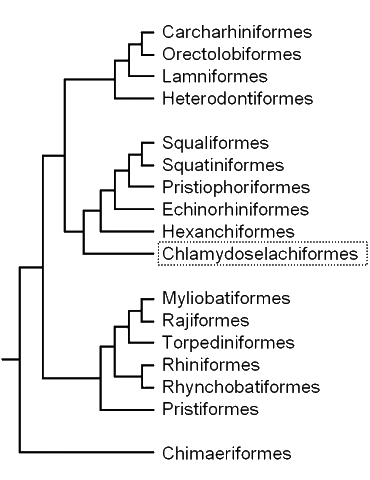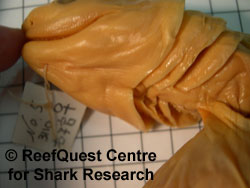Order Chlamydoselachiformes:
Frilled Sharks — 2 species

- body elongated and eel-like; snout blunt, jaws long and narrower at tip than at corners
- mouth terminal, upper and lower teeth with three prong-like cusps
- six gill-slits with frilly margins, the first continuous across the throat
- presence of an anal fin
- a single dorsal fin, located far back on the body
- ovoviviparous (retaining thin-shelled eggs within the mother's body, later to be born alive)
- exclusively marine, inhabiting deep outer continental shelf and slope waters; found in cold waters from boreal through temperate and tropical zones of the Atlantic, Pacific, and Indian Oceans
- 1 genus (Chlamydoselachus) in the family Chlamydoselachidae

|

|
 |
|
|
A representative chlamydoselachoid, the Frilled Shark (Chlamysoselachus anguineus) displays the eel-like body, terminal mouth, 'frilly' gill slits, single dorsal fin, and trident-shaped teeth characteristic of the group. |
|
Growing to a length of nearly 6.5 feet (2 metres), the eel-like Frilled Shark (Chlamydoselachus anguineus) has elaborate, collar-like gills — the first of which is continuous across the throat — and a terminal mouth armed with some 300 trident-shaped teeth arranged in about 25 rows. It has been suggested that its grasping teeth and the rearward position of most of its fins may allow the Frilled Shark to strike snake-like at its prey. Icthyologist Tadashi Kubota and his co-workers recently examined the food habits of the Frilled Shark in Saruga Bay, Japan. They found that about 60.5% of this species' diet consists of deep-sea squids and about 10.5% of deep-sea teleosts.
 Embryo Frilled Shark, showing first gill slit continuous across the throat. Preserved specimen in the collections of the LA County Museum |
A recent paper by Sho Tanaka of Tokai University and his co-workers has clarified aspects of the Frilled Shark's reproductive biology. Based on 264 specimens from Saruga Bay, Japan, this species appears to segregate by size and reproductive stage but has no defined reproductive season. Males are mature at less than 3.5 feet (1.1 metres) in length, while females reach sexual maturity between 4.6 and 5 feet (1.4 and 1.5 metres) in length. The Frilled Shark has the smallest litter size of any hexanchoid, ranging from 2 to 12 pups — with 6 being the average — each about 22 inches (55 centimetres) long. Recent studies off Japan by Sho Tanaka and his co-workers suggest that the gestation period of the Frilled Shark is at least 3.5 years. If correct, this is nearly twice as long as that of the African elephant (22 months) and by far the longest gestation period of any vertebrate.
The Frilled Shark usually inhabits deep waters between 400 and 4,200 feet (120 and 1,280 metres). This species is wide-ranging but spottily distributed, with most specimens coming from Japanese waters. According to some cryptozoologists, the eel-like Frilled Shark may be responsible for some 'sea serpent' sightings. Based on its trident-shaped teeth, relatively simple skeleton, and open lateral line, a few paleontologists deem it instead to be a living cladodont shark — an ancient group that included Cladoselache, which haunted Devonian seas some 380 million years ago. Although both suggestions are intriguing, they seem highly unlikely. The Frilled Shark rarely grows longer than about 6 feet (2 metres) and rarely — if ever — comes to the surface. And although some of its features resemble those of cladodonts, the Frilled Shark has numerous neoselachian skeletal and muscular features unknown in more archaic sharks.
Due to its many unusual features, the Frilled Shark is usually placed in its own family, Chlamydoselachidae, and recently systematist Shigeru Shirai has proposed that it warrants its own order as well. This taxonomic arrangement has been followed here. There appears to be an undescribed second species of Frilled Shark from southern African waters.
